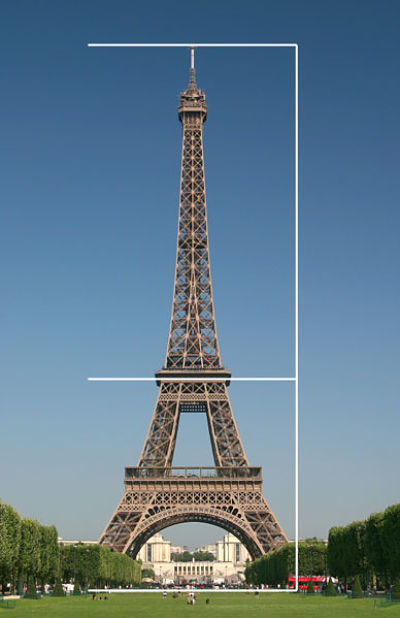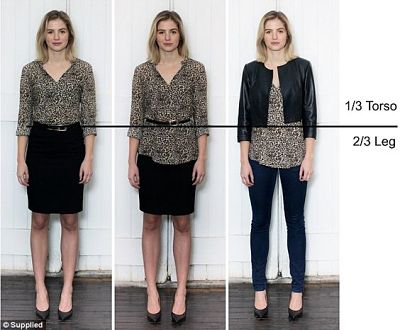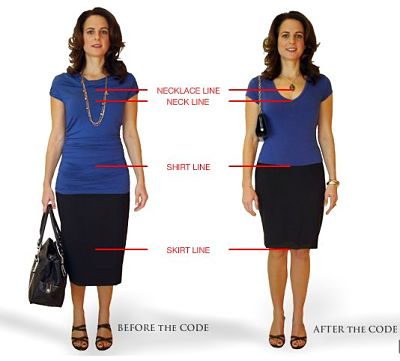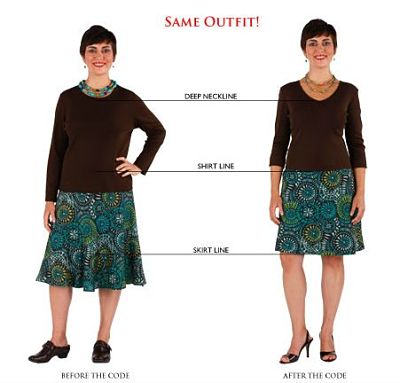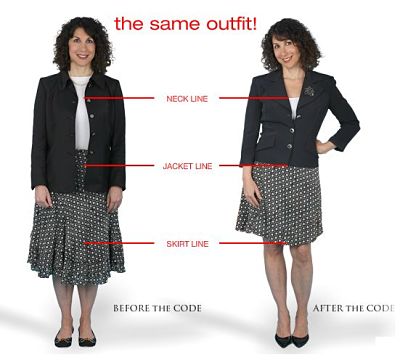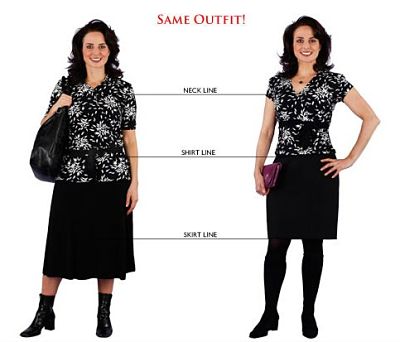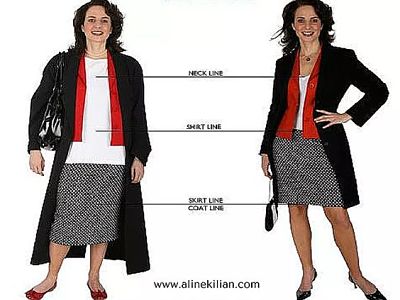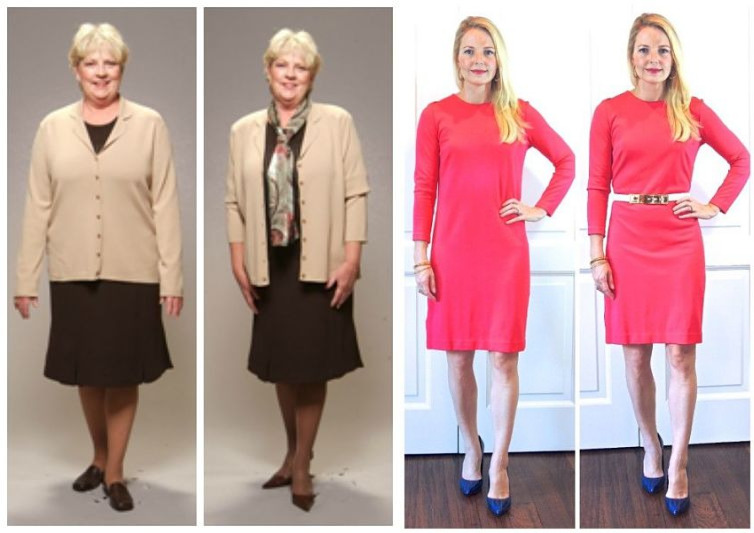Behind the Fashion Code
We’ve all been there . . . standing in front of a stuffed closet with nothing to wear, wondering what the real secret is to dressing well. You might think that not having a supermodel body, an unlimited budget or a personal stylist are the reasons for your wardrobe woes.
Take heart, your closet only seems to be filled with a chaotic clothing mess that no force of nature could ever squeeze a decent outfit out of. But, with The Fashion Code, that very same closet will soon be ruled by a mathematical principle of harmony, beauty, and proportion which has been around since the beginning of time.
Yes, for the first time ever, the constants which have governed the universe since fig leaves were in fashion, can now easily be used to create the wardrobe of your dreams. . . By following our simple formula, you will look 10 pounds thinner (or more!), 10 years younger, and without a doubt 10 times more stylish.
So, what is the secret behind “The Fashion Code”?
The amazing principle behind The Fashion Code is known as the Divine Proportion. It is also known as the Golden Ratio, Phi, or the Fibonacci Series. Since they all mean the same thing, from now on we’ll just be referring to them as the Divine Proportion or “The Code.”
For millions of years the Divine Proportion has been the universe’s own private secret for beauty. In nature everywhere it has helped to shape all that is. From the spiral forms of the galaxies to the placement of the planets, to the spacing of the petals in a rose. Mother Nature is not the only one who used this seemingly magical yardstick for beauty. Since the ancients “discovered” the Divine Proportion, we humans have used it to create masterpieces of our own, including The Parthenon, the Pyramids, the Mona Lisa, and the Eiffel Tower, just to name a few!
The Divine Proportion in Fashion
Here you see the Eiffel Tower, a structure that breaks visually into roughly 2/3 at the top, 1/3 at the bottom, and is considered one of the greatest structures ever erected. Many other buildings — including the Parthenon and the Great Mosque of Kairouan — are said to have been built to reflect this ratio in various elements of design. Painters and photographers use visual applications of the ratio to compose their works. The history is a little wiggly and there’s definitely disagreement, but many agree that a 2/3 to 1/3 division is generally aesthetically pleasing. (Or that thirds often work better than halves or quarters, as we see in this dressing example below
So how does that apply to dressing?
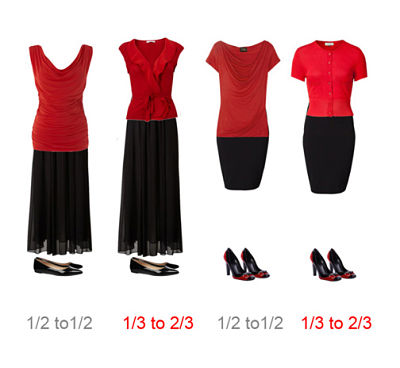 No example is perfect, but this one should give you the basic idea! On the far left is a maxi skirt outfit. Notice that the long tank top bisects the figure. On women with defined hips, this longer length top will cling to the butt, thighs, and hips. The second outfit pictured shows a considerably shorter top, and divides the figure into 1/3 up top and 2/3 on the bottom. See how much taller that second figure appears? This top also allows the skirt to flow freely, and doesn’t draw attention to the hips, but that’s secondary. The next outfit shows a long draped top with a pencil skirt. Again, the figure is bisected and the shirt ends abruptly at what is the widest point on the torso for many women. The final outfit shows the same skirt with a shorter top, and again the figure appears more proportionate. In this case, we discover that it’s mostly about focusing on thirds instead of halves or quarters. So with a shortish skirt and bare legs, your sweater/blouse comprises the top third, skirt is the middle third, and legs are the bottom third. (Roughly, of course.)
No example is perfect, but this one should give you the basic idea! On the far left is a maxi skirt outfit. Notice that the long tank top bisects the figure. On women with defined hips, this longer length top will cling to the butt, thighs, and hips. The second outfit pictured shows a considerably shorter top, and divides the figure into 1/3 up top and 2/3 on the bottom. See how much taller that second figure appears? This top also allows the skirt to flow freely, and doesn’t draw attention to the hips, but that’s secondary. The next outfit shows a long draped top with a pencil skirt. Again, the figure is bisected and the shirt ends abruptly at what is the widest point on the torso for many women. The final outfit shows the same skirt with a shorter top, and again the figure appears more proportionate. In this case, we discover that it’s mostly about focusing on thirds instead of halves or quarters. So with a shortish skirt and bare legs, your sweater/blouse comprises the top third, skirt is the middle third, and legs are the bottom third. (Roughly, of course.)
Now this will not work for everyone. As a matter of fact, nothing does! There are no universal, foolproof, one-rule-fits-all guidelines in style, figure flattery, or dressing. My hope, though, is that seeing these examples and learning about this idea might help a few of you understand why certain outfits make you peer into the mirror and say, “Huh. Something is definitely off here, but I haven’t the foggiest what it is.” Many times, it’s a matter of proportions and garment length, and applying the Golden Ratio may make you feel more like it’s on-kilter
Its power to create the perfect outfit is truly extraordinary
Here we see some dramatic examples wearing THE EXACT SAME OUTFIT in both the BEFORE and AFTER photos. Notice how much more slim and stylish she looks in the after photo. What made the difference? We simply applied the easy and inexpensive secret of The Fashion Code to reveal her ideal clothing proportions and transform her outfit and her look.
Then Imogene Lamport from Insideoutblog.com shows us a couple of ways to use the Golden Ratio to dress in a proportioned manner that is flattering
Hopefully, these examples have given you a better of sense of proportion in choosing your clothes. Be sure to visit our Stylish Crossdressers on Sister House and peruse our many fine article in Putting It Together in the Dressing Room
Resources: The Fashion Code , Already Pretty
Category: Style, Transgender Fashion, Transgender How To


